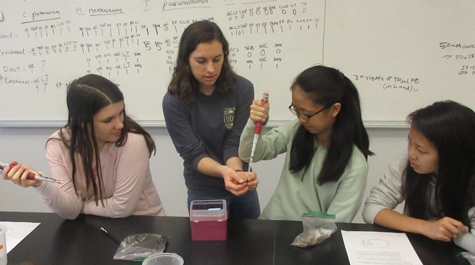Jamestown High students plunge into science during phage lab visit
The day started off with pipetting basics and ended with a hunt for new bacteriophages.
In between, there were hands-on introductions to a series of sophisticated lab techniques not generally available to high school students. There also was lunch.
It made April 24 quite a full day for 29 students from John Leone’s honors biology class at Jamestown High School. They were guests of William & Mary students, notably members of the university’s prize-winning iGEM team.
The iGEM Foundation is dedicated to the advancement of synthetic biology. Each year, the foundation stages an international competition to find the best projects in biomolecular engineering. William & Mary teams are perennial high performers, bringing home First Runner-Up honors in 2017 and winning the Grand Prize in 2015.
Margaret Saha points out that education is a large part of the iGEM ethos, and the William & Mary teams offer a number of outreach activities throughout the year. The April 24 visit by Leone and his students was only the most recent. Leone said the hands-on wet-lab experience at William & Mary gives a solidity to the students’ understanding of how science is done.
He said his students know that DNA is used for paternity testing and criminal investigation and that genetic engineering holds great promise for human-health issues. He expects his students would leave the university’s Integrated Science Center with a better concept-to-practice connection.
“This is something we can’t do back at school, because we don’t have the equipment,” Leone said. “So unfortunately, we can only talk about the concepts. To bring them here, to work with the DNA and work with all these procedures, really helps with their learning.”
The Jamestown honor bio students split up into groups and, after introductions and an overview, they learned how to use micropipettes. Pipetting is a standard wet-lab technique for transferring small amounts of liquid.
Alyssa Luz-Ricca ’20, a member of the 2017 iGEM team, urged her table of students to take care with the pipettes. They act on the principle of a turkey baster, “but they are really precision instruments,” she said. “And they are expensive!”
After the students got the hang of pipetting, they moved on to learning how to perform a standard biotech technique known as a restriction digest. This procedure uses enzymes to dissolve bonds — or “cut” — DNA at specific locations to allow insertion of a DNA fragment from another source.
Mentored by the William & Mary students, the visitors designed their own restriction digest experiment. Then each high school student was able to load his or her individual sample into gel electrophoresis apparatus, learning how this technique uses electricity to “sieve” charged molecules such as proteins, DNA and RNA.
The instruction then moved to a polymerase chain reaction experiment, a procedure to copy or clone genetic material. The exercise was designed so that the Jamestown group prepared their PCR reactions, to be be run later by William & Mary volunteers, who will send results electronically for Leone’s students to analyze in class.
The Jamestown students were asked to bring their own soil samples for the day’s final experience, which centered around bacteriophages. Bacteriophages are viruses that exist in a seemingly limitless variety. Phages are the subject of a research-based freshman lab experience at William & Mary, supported by funding from the Howard Hughes Medical Institute. In fact, the April 24 event was held in the phage lab in the ISC and the Jamestown students completed their own phage assay, looking for phages in their own samples.
Leone circulated from group to group during the day. He has brought classes to biology outreach events before and talked about the value of the experience for his students.
“I’ve had students tell me after we’ve had these visits that they were more interested in biology,” Leone said. “What they learn here reinforces the concepts, but it also possibly motivates them to major in biology.”
 Skip to main content
Skip to main content

